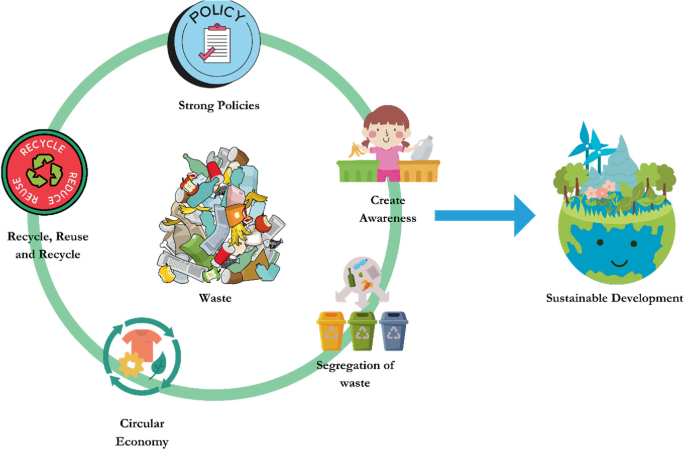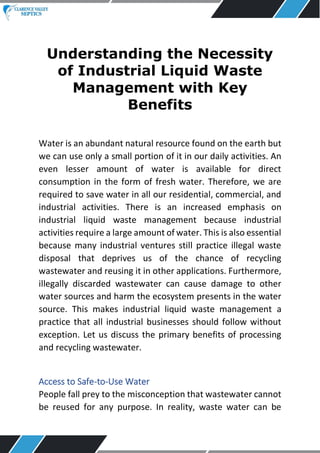The 9-Minute Rule for Reclaim Waste
The 9-Minute Rule for Reclaim Waste
Blog Article
Reclaim Waste - An Overview
Table of ContentsExcitement About Reclaim WasteEverything about Reclaim WasteThe Best Guide To Reclaim WasteThe Definitive Guide for Reclaim WasteThe Single Strategy To Use For Reclaim WasteThe 15-Second Trick For Reclaim Waste
Via correct liquid waste management, companies can minimize energy-intensive therapy procedures and disposal costs. By following a system for handling liquid waste, firms can stay clear of pricey penalties and fines and prevent negative promotion.Remain ahead of policies and maintain a risk-free work environment with a digitized conformity tool. Classifying liquid waste is critical for reliable storage, treatment, and disposal. Environmental, Health And Wellness, and Security (EHS) teams, waste administration policemans, and conformity managers can deal with these wastes safely and efficiently when they comprehend the essentials: Generated from homes, this type of fluid waste comes from commodes, sinks, showers, and washing machines.
(https://www.pearltrees.com/reclaimwaste1#item691249862)Gather representative examples from various factors within the waste stream to ensure accuracy. Conduct periodic testing to track any type of adjustments in the make-up. Maintain thorough documents of characterization for future referral and compliance functions. Liquid waste, specifically hazardous ones, poses significant risks during this action. Correct procedures lessen spills, leaks, and other crashes that could harm the workers and the general public.
The smart Trick of Reclaim Waste That Nobody is Discussing
Segregate the waste based upon its type (e.g., dangerous or non-hazardous) to make certain proper handling. Store waste in safe and secure and leak-proof containers to avoid spills during collection. Label the containers properly, consisting of the sort of waste, possible hazards, and taking care of guidelines. Load the safeguarded containers right into transport lorries with vacuum cleaner vehicles or mobile containers.
Sanitation (e.g., chlorination, ultraviolet light, ozonation) and nutrient removal (e.g., denitrification and phosphorus removal) are suggested under strict laws. Countless companies violated several fluid waste disposal guidelines in recent years.
After picking the most effective sort of therapy method for fluid waste, firms should discover means to get rid of this properly. Below are some efficient methods of fluid waste administration: receive most dealt with fluid waste that meets discharge criteria. refers to utilizing cured wastewater in farming lands for watering as long as the effluent fulfills hygienic levels per regulations.
Top Guidelines Of Reclaim Waste
Shallow basins include fluid waste that is enabled to vaporize through all-natural procedures. This kind of disposal is subject to rigorous ecological laws due to possibly unsafe exhausts.
The findings need to be recorded, assessed, and stored not simply for submission to regulative authorities yet additionally for making improvements in the future. Share information with appropriate stakeholders (e.g., workers, regulatory government firms, and close-by neighborhoods) to maintain openness and liability.
An Unbiased View of Reclaim Waste
Despite the business size or market, there are countless difficulties related to this job. Recognizing these can aid them properly handle their procedures and lessen their environmental influence. makes it difficult to deal with and take care of fluid waste safely. Firms that can not buy centers ought to consider working together with the public field for far better solutions.
Liquid waste refers to any product in a fluid state that is excess, undesirable, or disposed of. One considerable obstacle for business is the absence of suitable storage facilities for fluid waste. Partnering with fluid waste solutions will considerably reduce this challenge Standard miss bins and various other containers that are generally utilized for solid waste are frequently inadequate for the unique requirements of managing liquid materials.
The Best Guide To Reclaim Waste
This blog site dives right into the characteristics of liquid waste, discussing how spills and contamination cases can be managed effectively. It likewise checks out the actions firms can require to avoid future leakages and what to do when spills undoubtedly take place. Fluid waste consists of any type of undesirable or surplus material that exists in a fluid type and is established for disposal.
This kind of waste occurs when a product is no more required, much like any type of other form of garbage. Sometimes, this indicates simply tossing it away, which can happen as an outcome of generating even more than needed. Liable management via correctly disposing is a must. It is crucial to engage skilled fluid waste monitoring specialists when transferring or getting rid of liquid waste.

What Does Reclaim Waste Do?
The Environmental Protection Agency states the "material needs to travel through a 0.45-micron filter at a stress differential of 75 psi" in order to be defined Full Report as a fluid. What is essential to note right here is that the much more solid a product is, the less likely it is to be liquid. It's feasible to set apart in between 2 kinds of liquid waste: natural and inorganic. Both have their differences.
Both services and individuals can significantly profit from recognizing appropriate trash disposal processes through 9 best techniques in waste management. These strategies are lined up with the well-known waste pecking order.

Report this page